Expanded clay floor screed
A perfectly flat floor is a criterion for evaluating quality repairs, a component of comfort, a guarantee of technically correct execution of subsequent laying of the coating. Gross mistakes by builders, significant differences in the levels of the lower surface make it difficult to install door structures and drywall partitions, and make them resort to various tricks when decorating walls. There are true ways to deal with the reality that is not always on the conscience of the builder. One of the effective and economical methods for the complete elimination of unevenness and height differences is a floor screed with expanded clay. It allows not only to perfectly level the surface, but also to increase the insulation characteristics.
Content
- Goals and objectives of the screed
- Expanded clay screed options
- Careful preparation is a step to success
- Two ways to pour screeds with expanded clay
Sometimes visually undetermined deviations and defects of the subfloor exclude the possibility to equip the premises with the help of selected materials. An uneven surface is incompatible with laying parquet, practical linoleum. It becomes impossible to install floating floors made of natural materials, impossible to floor ceramic tiles. In addition, the floor is the most conservative interior surface, less often than others being repaired. Therefore, they look like its decoration thoroughly, thoroughly preparing this element of the interior for long-term operation. The wear resistance and technical advantages of expanded clay screed convince most homeowners in multi-storey buildings and owners of suburban mansions to choose this particular type of arrangement.
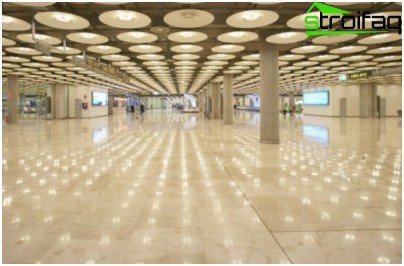
A perfectly smooth surface is the result of a quality screed
Goals and objectives of the screed
The main purpose of floor screed is surface leveling. Performing screed using expanded clay simultaneously solves a number of additional tasks. In the process, not only hollows, bumps are eliminated, the level is leveled, but the penetration of sound vibrations is also significantly reduced. Having excellent thermal insulation properties, the amorphous material perfectly performs the function of a barrier against heat loss. Through the use of expanded clay, costs are reduced in the heating season, and in the summer heat, active use of air conditioners is not required. As a result, the expanded clay screed, related to the middle price segment, by reducing costs will result in tangible savings.
The reasons justifying the choice of this alignment scheme with expanded clay as the most rational way:
- the difference in floor levels in the room is over 10 cm;
- the basis for laying the floor is reinforced concrete or concrete slabs;
- it is planned to equip with a floor covering, the aesthetic qualities of which and the strength indicators will be affected by defects in the subfloor;
- the floor is equipped with an infrared or electric heating system;
- it is necessary to reduce the consumption of cement;
- it is necessary to increase sound insulation;
- in the zone of the lower floor there are communications laid in a hidden way.
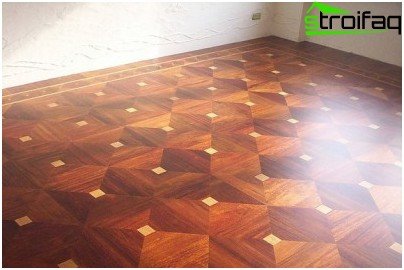
The advantage of floor screed with expanded clay is excellent work with any floor covering.
The advantage of screed with expanded clay is the combination of lightness and strength. Thanks to the use of expanded clay granules, crushed stone, sand or their combination, the load on the floors is minimized. The low specific gravity of the material does not prevent the floor from adequately resisting static and dynamic loads. During long-term intensive use, the quality of such a floor will not suffer at all.
Expanded clay priorities are justified by the specifics of its production. Fusible finely dispersed clay, foamed in a special way, is subjected to high-temperature firing. As a result of sintering, light granules are obtained with a strong outer shell, which prevents the penetration of moisture. The presence of cavities and air bubbles provides low thermal conductivity and excellent insulating qualities; they also explain insignificant specific gravity indicators. The porous insulating material embodies the priority properties of wood and stone. Expanded clay is light, strong, moisture resistant, inert, works perfectly with any of the building materials..
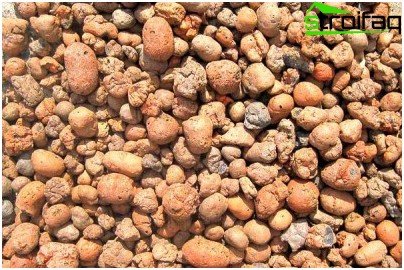
Expanded clay – strong lightweight wear-resistant aggregate for floor screed
Expanded clay material is divided according to the criteria of fractional size and the content of acute-angled elements, it is presented:
- sand with a particle size of up to 5 mm obtained after sieving the calcined amorphous mass;
- gravel, including rounded and oval particles, the diameter of which reaches 40 mm;
- crushed stone, including angular particles with a diameter of up to 40 mm.
Often, floor screed with expanded clay is carried out using a fractional mixture, thereby increasing the density of the insulating and leveling layer. Since in the predominant number of cases the expanded clay layer is covered with a bulk floor, gypsum-fibrous sheets or other material for leveling, the size and configuration of the particles do not matter.
Note. If it is necessary to minimize the weight of the structure, do not use expanded clay sand. With an increase in packing density, the weight will also increase.
However, there are options when the arrangement of the floor involves only the use of fine-grained material, for example, when laying piece parquet.
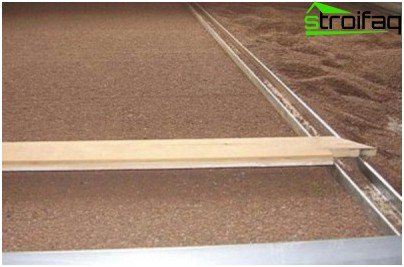
Fine-grained expanded clay aggregate for floor screed
The material characterized by minimal shrinkage indicators is an indispensable component of flooring with large level differences with a height difference of 10 or more cm. Expanded clay is used to level the difficult part of the floor, since it gives the slightest shrinkage.
Expanded clay screed options
Expanded clay aggregate, which can significantly reduce the consumption of a binder, is used when leveling the floor in various ways. Currently, during the construction process, during the restoration and repair work, three technologies are used:
- leveling and warming the floor with expanded clay and cement-sand mortar;
- bulk floor using expanded clay aggregate;
- dry screed with expanded clay.
The work performed in accordance with technological requirements and building codes will ensure long service to the floor, communication systems and floor coverings located under it. The owners will not have problems during operation, for a long time they will not need cosmetic and major repairs.
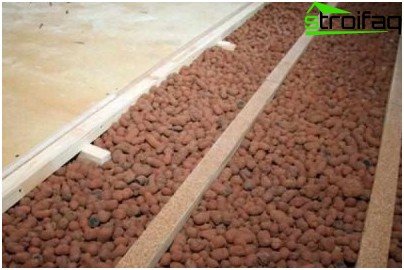
Leveling and warming the floor using expanded clay backfill and pouring cement-sand mortar
To level the rough floor, you can order the services of workers of the construction and repair organization. A simple but laborious process can be performed independently by purchasing the necessary amount of materials. The flow rate should be calculated based on the data given by the manufacturer in the instructions. Based on the technical information about the material, taking into account the volume of the floor to be leveled, the requirements for the material are calculated, an approximate estimate is made. You can see clearly how floor screeding with expanded clay is performed – video materials, photo collections with a description will help to present and study in detail the sequence of work on flooring.
Careful preparation is a step to success
The beginning of work on floor leveling is traditionally the dismantling of the floor covering and the preparation of the cultivated area. The floor is disassembled to the base, then it is necessary to remove the entire volume of construction waste. The holes in the floor must be carefully cleaned, the cables and wires inside it are wrapped in polyethylene. The joints of the polyethylene insulation must be tightly wrapped with tape so that crumbs, dust or mortar do not get.
Waterproofing the base of the floor is done under Self-leveling floors and for leveling using cement-sand mortar for pouring. The material can be a special mastic. Most often, a thickened dense plastic film, isolan or hydroisol is used. Waterproofing materials:
- create a damper layer between the wall and the screed;
- prevent the adhesion of the mortar with building materials, which often becomes the cause of cracking of cement screed during drying;
- reduce the transmission of sound waves coming from the screed to the partitions and supporting structures.
Waterproofing is a prerequisite when covering the insulation screed, when installing parquet, when processing the floor in contact with the basement. Roll insulation materials are placed 15 cm above the marked level of the floor screed with expanded clay. After completion of the installation of flooring, they are trimmed at the level of the upper plane.
The final stage of preparation consists in exhibiting beacons that serve as a reference point for leveling the surface at the same level. Lighthouses can be ordinary self-tapping screws or special metal devices of a T-shape, produced to equip the screed. The correct marking will help make the laser level, the price of which allows you to purchase a useful device for permanent household use, or an elementary home-made hydraulic level made of a transparent barrier. Lighthouses are set in accordance with the marks left on the walls during marking.
Two ways to pour screeds with expanded clay
- First option. Expanded clay aggregate is poured, compacted and leveled, the surface of which should not reach the floor level marked by beacons. The distance between the marks and the expanded clay layer should not exceed 2 cm. Then, the entire treated area is poured with cement liquid “milk” to fix the position of expanded clay granules. After hardening, a cement mortar is poured, which can be prepared independently from sifted sand and cement marked M 400. In order to eliminate errors with proportions, you can purchase a ready-made mixture for screed.
- The second option. Expanded clay is initially introduced into the solution by kneading using a construction mixer. For the convenience of applying the mixture, the floor in the room is divided using beacons into cards – specific segments to be sequentially processed. The laid out mixture with expanded clay is constantly leveled with the help of a rule device. In places of formation of dimples and puddles add cement. The floor screed with expanded clay according to this scheme, as according to the previous technology, begins at any of the walls, you need to move to the doorway.
Both options are suitable for installing a subfloor for any floor covering..
Bulk floor with expanded clay aggregate
Self-leveling floors provide the formation of a perfectly flat surface due to the ability of the composition to spontaneously level out. Full hardening occurs after a maximum of a week, which is 3-4 times faster than both methods of leveling with cement-sand mortar. Now you can buy the finished mixture with expanded clay for the device of the bulk floor. In addition to expanded clay, its composition also contains a number of additives that improve the characteristics of the floor structure.
If the finished composition is not used for the arrangement, then the screed begins with a uniform distribution of expanded clay scattered over the entire area. When laying expanded clay on a dry base, waterproofing is optional. Tamped and leveled similarly to the previous methods, the material is covered with a plastic film or other insulation. Then the solution is poured, from which it is necessary to expel excess air with a needle roller.
The cheapest and fastest way, which does not require a long wait for the floor to harden, is a dry, practical floor screed with expanded clay. Stages of work on this technology include:
- marking the future floor height;
- laying the waterproofing layer on the base;
- fastening the damper film around the perimeter of the treated room;
- filling, tamping and leveling the expanded clay layer;
- installation on top of expanded clay gypsum sheets with the processing of butt joints with PVC glue and fixing elements with screws.
The floor screed with expanded clay at the same time performs several significant functions: it increases the aesthetic and thermal characteristics of the room. The floor, equipped with one of the methods using expanded clay, will not have to be repaired. The coating laid on a perfectly smooth surface will last much longer than that made on top of an uneven base.






